Chest Physiotherapy
Chest physiotherapy (PT) includes postural drainage, chest percussion and vibration, and coughing and deep-breathing exercises. Together, these techniques mobilize secretions, help to reexpand lung tissue, and promote efficient use of respiratory muscles. Of critical importance to the bedridden patient, chest PT helps prevent or treat atelectasis and may also help prevent pneumonia—two respiratory complications that can seriously impede recovery.
Postural drainage performed in conjunction with percussion and vibration encourages peripheral pulmonary secretions to empty by gravity into the major bronchi or trachea and is accomplished by sequential repositioning of the patient. Usually, secretions drain best with the patient positioned so that the bronchi are perpendicular to the floor. Lower and middle lobe bronchi usually empty best with the patient in the head-down position; upper lobe bronchi, in the head-up position. (See Positioning patients for postural drainage, pages 162 and 163.)
Percussing the chest with cupped hands mechanically dislodges thick, tenacious secretions from the bronchial walls. Vibration can be used with percussion to enhance secretion mobility or as an alternative to it in a patient who is frail, in pain, or recovering from thoracic surgery or trauma.
Candidates for chest PT include patients who produce large amounts of sputum, such as those with bronchiectasis and cystic fibrosis.1,2 The procedure hasn’t proved effective in treating patients with status asthmaticus, lobar pneumonia, or acute exacerbations of chronic bronchitis when the patient has scant secretions and is being mechanically ventilated. Chest PT has little value for treating patients with stable, chronic bronchitis.
Contraindications may include active pulmonary bleeding with hemoptysis and the immediate posthemorrhage stage, fractured ribs or an unstable chest wall, lung contusions, pulmonary tuberculosis, untreated pneumothorax, acute asthma or bronchospasm, lung abscess or tumor, bony metastasis, head injury, and recent myocardial infarction.1
Equipment
Stethoscope ▪ pillows or folded towels for positioning ▪ tilt or postural drainage table (if available) or adjustable hospital bed ▪ gloves ▪ emesis basin ▪ facial tissues ▪ suction equipment ▪ equipment for oral care ▪ trash bag ▪ Optional: sterile specimen container, mechanical ventilator, supplemental oxygen.
Preparation of Equipment
Gather the equipment at the patient’s bedside. Set up suction equipment and test its function.
Positioning Patients for Postural Drainage
The following illustrations show the various postural drainage positions and the areas of the lungs affected by each.
Lower Lobes: Posterior Basal Segments
Elevate the foot of the bed 30 degrees. Have the patient lie prone with his head lowered. Position pillows under his chest and abdomen. Percuss his lower ribs on both sides of his spine.
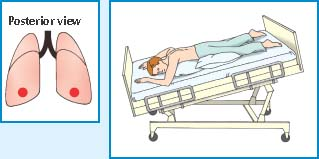 |
Lower Lobes: Lateral Basal Segments
Elevate the foot of the bed 30 degrees. Instruct the patient to lie on his abdomen with his head lowered and his upper leg flexed over a pillow for support. Then have him rotate a quarter turn upward. Percuss his lower ribs on the uppermost portion of his lateral chest wall.
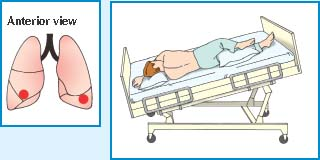 |
Lower Lobes: Anterior Basal Segments
Elevate the foot of the bed 30 degrees. Instruct the patient to lie on his side with his head lowered. Then place pillows as shown. Percuss with a slightly cupped hand over his lower ribs just beneath the axilla. If an acutely ill patient has trouble breathing in this position, adjust the bed to an angle he can tolerate. Then begin percussion.
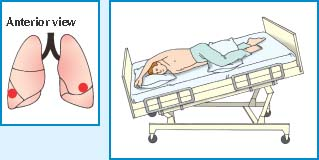 |
Lower Lobes: Superior Segments
With the bed flat, have the patient lie on his abdomen. Place two pillows under his hips. Percuss on both sides of his spine at the lower tip of his scapulae.
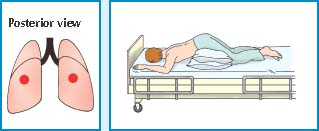 |
Right Middle Lobe: Medial and Lateral Segments
Elevate the foot of the bed 15 degrees. Have the patient lie on his left side with his head down and his knees flexed. Then have him rotate a quarter turn backward. Place a pillow beneath him. Percuss with your hand moderately cupped under the right nipple. For a woman, cup your hand so that its heel is under the armpit and your fingers extend forward beneath the breast.
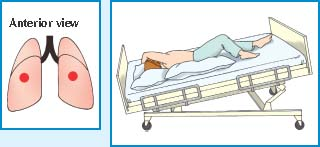 |
Left Upper Lobe: Superior and Inferior Segments, Lingular Portion
Elevate the foot of the bed 15 degrees. Have the patient lie on his right side with his head down and knees flexed. Then have him rotate a quarter turn backward. Place a pillow behind him, from shoulders to hips. Percuss with your hand moderately cupped over his left nipple. For a woman, cup your hand so that its heel is beneath the armpit and your fingers extend forward beneath the breast.
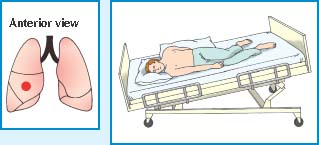 |
Stay updated, free articles. Join our Telegram channel

Full access? Get Clinical Tree


Get Clinical Tree app for offline access
